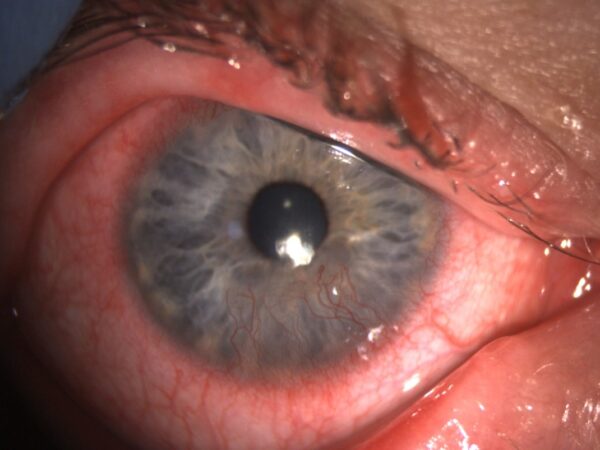Vetting Cataract Referrals
The cataract pathway journey often starts with the patient being examined by their community optometrist and referred to their local ophthalmology department for consideration of treatment for their cataract. It is thought that across the UK approximately 400,000 cataract operations are performed each year, accounting for around 6% of all surgery undertaken, so it is little wonder that we are conscious of a steady stream of new referrals entering our busy departments.
One of the key stages of the cataract pathway is the initial vetting of referrals when they arrive into the hospital eye service. There can be dozens of new referrals each week so it can be a time consuming task. Referrals may still arrive in paper format or increasingly nowadays through an electronic referral system.
Whoever is vetting these letters relies on a complete and concise level of information being included in the referral. The Cataract Assessment Course highlights the following elements as being the key information to be included in a complete referral allowing for accurate vetting:
- Patient identifying and contact details
- History and symptoms overview including any changes in their vision and any relevant ocular and general health conditions
- An indication of how the cataract affects their everyday life and that the patient is keen to be considered for surgery
- Social factors – driving status, employment, if they act as a carer
- Complete ocular examination under dilation including anterior segment, the lens and the fundus
- Spectacle refraction and visual acuity
- Other measures such as IOP
- Ocular co-morbidities highlighted
- Restrictions or challenges for assessment and surgery such as reduced mobility, communication or cognitive function
This information provides the vetting member of the team with a solid basis for directing the patient onto the appropriate pathway and with the appropriate degree of urgency.
Most regions will use a standardised cataract referral template which greatly helps in the initial allocation of referrals for vetting. When working through these the following are the main aims:
- Confirm the referral type as being for the cataract treatment pathway
- Check for any other ocular conditions mentioned which may require allocation onto a different pathway, in addition to the cataract pathway
- To decide on the degree of urgency with which the patient should be assessed for their cataract
- Identify any possible challenges which might determine the type of clinic where the patient should be assessed.
Let’s have a look at each of these areas in more detail.
Confirming the referral type
It is important to confirm that the referral is primarily intended for the cataract pathway and that it isn’t for a different ocular condition. Quite a common mistake is for Posterior Capsular Opacification (PCO) to be misread as Posterior Subcapsular Cataract (PSCC) and booked into a cataract clinic rather than a YAG laser clinic. This is quite easily done, particularly when working through a large volume of referrals, however it can inconvenience the patient and possibly cost a slot on a busy cataract assessment clinic.
It should be ascertained that the cataract is interfering with the visual function and the patient is keen for treatment.
The referring optometrist however in a lot of cases will have reviewed that patient on a number of occasions and will be well placed to determine that the patient is at the point of requiring treatment.
Other conditions mentioned on the referral
There can be a wide variety of other ocular conditions and findings mentioned on the referral which might affect which pathway(s) the patient should be allocated to.
The majority will be straightforward cataract referrals which require vetting for cataract assessment only.
Some may also mention macular pathology which may require additional input. Any findings which indicate that there could be wet AMD present should be vetted to the medical retina/ macular pathway on a rapid timescale. A lot of patients will have dry AMD recorded. This generally doesn’t require additional assessment, however needs to be examined during the cataract assessment and the patient counselled in terms of their prospects of visual improvement through cataract surgery.
Sometimes glaucoma findings may be reported in the referral as well as cataract, so it may be that the patient needs a glaucoma assessment as well as cataract assessment. In these cases it is worth checking if they are already being seen in the department in order to avoid duplication of appointments.
Other clinical factors may also be mentioned in the referral such as the presence of pseudo-exfoliation or corneal guttata. These do not require any other additional clinical input, however will be reported in the referral in order to highlight these risk factors.
Deciding on the degree of urgency
Assigning a degree of urgency to each cataract case is a really important aspect of the vetting process. Most departments will exercise two categories for vetting – routine and urgent and will have some criteria or guidelines relating to these. It is a balancing act as it is human instinct to want patients to be seen sooner however, it is important not to oversubscribe your urgent waiting list to the point that the people who genuinely need help on a short timescale become delayed.
The other difficulty is that no two patients are the same – they have different visual demands and levels of symptoms. There are a variety of factors to take into account when trying to decide whether someone needs to be seen routinely or urgently for their cataract operation:
- The level of visual acuity in both eyes. Some services may have a level of visual acuity in the better eye that is used as a cut-off point in deciding if someone is urgent. This can be helpful however doesn’t take into account other factors such as glare or the different visual demands of patients.
- The patient’s vision has dropped below the legal driving standard
- The level of vision is inadequate for the patient to be able to perform their job
- There is a risk of falls and harm due to reduced vision
- Patient unable to care for themselves or a loved one due to reduced vision – difficulty in seeing their medications for example. Cooking and other everyday tasks affected.
- Patient on end-of-life care and vision significantly reduced, taking away from their quality of life.
- Elderly patients who rely on TV and reading as their main source of enjoyment being unable to do these things can have a detrimental effect on quality of life and increase social isolation.
This list is not exhaustive but gives some illustration of the type of cases which warrant more urgent attention. It is important to not to try to place hard and fast rules to this, and to exercise some clinical judgement when assessing these referrals.
Factors that might influence which clinic to bring the patient to
The majority of referrals will be routine and will come to the regular cataract assessment clinic. In certain cases where assessment might be more challenging or obtaining consent is more difficult, the patient should be seen in a consultant led cataract assessment clinic, rather than one delivered by an optometrist for example.
In these more challenging cases it can be very useful for the surgeon who is likely to be performing the surgery to be able to assess the patient in person so they can decide on any special arrangements or considerations that need to be made. A common scenario is when an older patient has dementia so their capacity to consent to surgery is reduced.
Other situations where surgery is likely to be technically difficult due to reduced mobility or posture, patient tremor, deep-set eyes or very dense/mature cataract, for example, it can be beneficial for the surgeon to be able to assess the patient in person beforehand.
Where there is or has been other pathology present for example a repair for a retinal detachment, the vitreo-retinal specialist might be best placed to assess and treat the cataract. Similarly, if the patient has advanced glaucoma or had previous glaucoma surgery, the glaucoma specialist may be best placed to treat the cataract. Corneal pathology is another area where the relevant specialist may need to input to the patient management. It is worth knowing what the policy is within your department for such cases, so that they can be assigned correctly.
Conclusion
To summarise, the role of vetting cataract referrals is a large task in any department. When done well it aims to get the patient seen on the correct clinic within the appropriate timeframe. This helps the cataract service to function as best possible and minimises inconvenience to the patient through being assigned to the incorrect clinic.
It relies heavily on the appropriate level of information on the referral and for it to be read in detail so that any relevant findings can be taken into account.
If the level of detail isn’t adequate, it may be safer to contact the person referring the patient to request any missing information, rather than trying to vet the referral regardless.
The degree of urgency for the patient is often steered by your departmental guidance on this and a certain amount of clinical judgement given that two patients are rarely the same.
If you are uncertain about how to vet any particular case, it is always appropriate to gain the advice of a colleague rather than trying to make the decision alone, and to use this as a learning opportunity.
Latest Articles




HCP Popup
Are you a healthcare or eye care professional?
The information contained on this website is provided exclusively for healthcare and eye care professionals and is not intended for patients.
Click ‘Yes’ below to confirm that you are a healthcare professional and agree to the terms of use.
If you select ‘No’, you will be redirected to scopeeyecare.com
This will close in 0 seconds